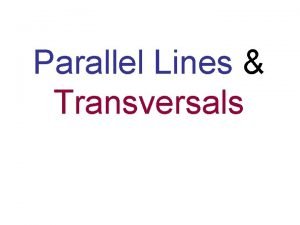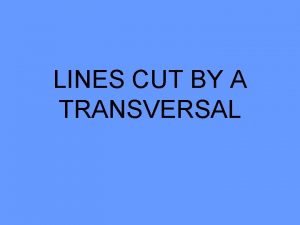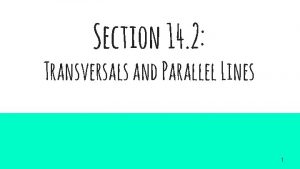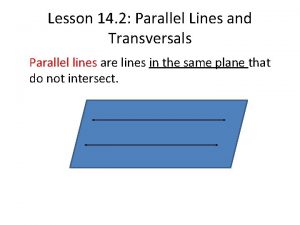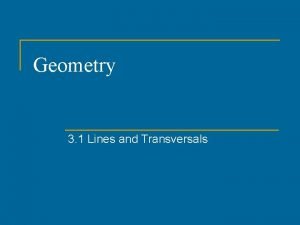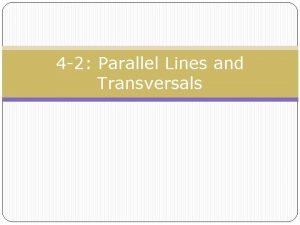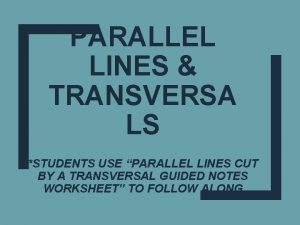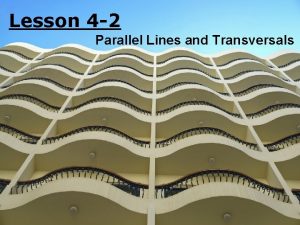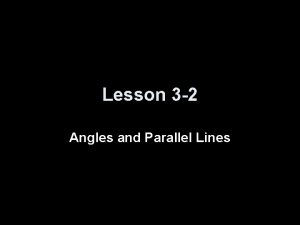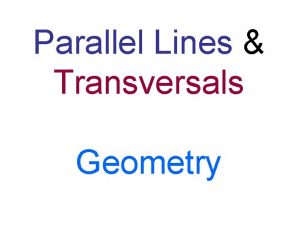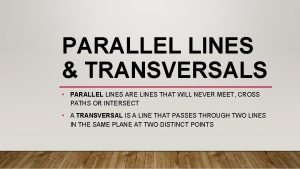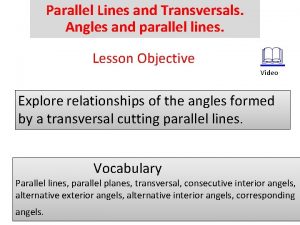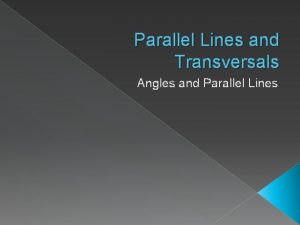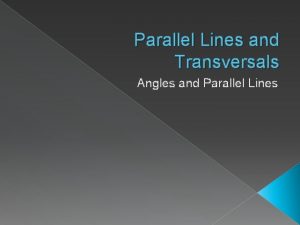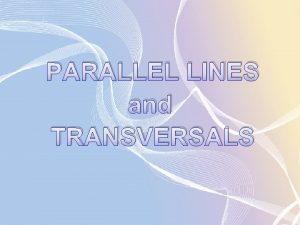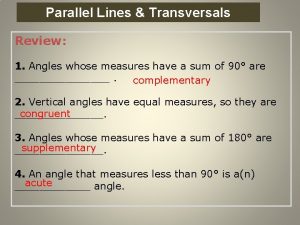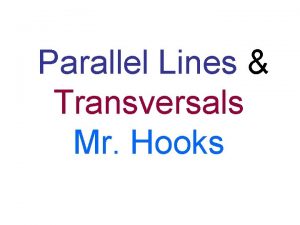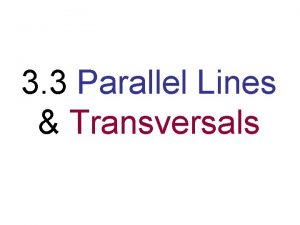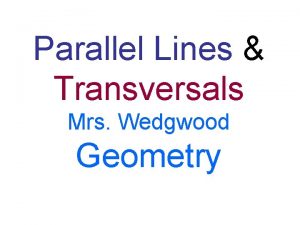3 3 Parallel Lines and Transversals Warm Up













- Slides: 13

3 -3 Parallel Lines and Transversals Warm Up Lesson Presentation Lesson Quiz Holt Geometry

3. 3 Parallel Lines and Transversals Warm Up Identify each angle pair. 1. 1 and 3 corr. s 2. 3 and 6 alt. int. s 3. 4 and 5 alt. ext. s 4. 6 and 7 same-side int s

3. 3 Parallel Lines and Transversals Objective Prove and use theorems about the angles formed by parallel lines and a transversal.

3. 3 Parallel Lines and Transversals

3. 3 Parallel Lines and Transversals Example 1: Using the Corresponding Angles Postulate Find each angle measure. A. m ECF x = 70 Corr. s Post. m ECF = 70° B. m DCE 5 x = 4 x + 22 x = 22 m DCE = 5 x = 5(22) = 110° Corr. s Post. Subtract 4 x from both sides. Substitute 22 for x.

3. 3 Parallel Lines and Transversals Check It Out! Example 1 Find m QRS. x = 118 Corr. s Post. m QRS + x = 180° m QRS = 180° – x Def. of Linear Pair Subtract x from both sides. = 180° – 118° Substitute 118° for x. = 62°

3. 3 Parallel Lines and Transversals Helpful Hint If a transversal is perpendicular to two parallel lines, all eight angles are congruent.

3. 3 Parallel Lines and Transversals Remember that postulates are statements that are accepted without proof. Since the Corresponding Angles Postulate is given as a postulate, it can be used to prove the next three theorems.

3. 3 Parallel Lines and Transversals Example 2: Finding Angle Measures Find each angle measure. A. m EDG = 75° Alt. Ext. s Thm. B. m BDG x – 30° = 75° Alt. Ext. s Thm. x = 105 Add 30 to both sides. m BDG = 105°

3. 3 Parallel Lines and Transversals Check It Out! Example 2 Find m ABD. 2 x + 10° = 3 x – 15° Alt. Int. s Thm. x = 25 Subtract 2 x and add 15 to both sides. m ABD = 2(25) + 10 = 60° Substitute 25 for x.

3. 3 Parallel Lines and Transversals Example 3: Music Application Find x and y in the diagram. By the Alternate Interior Angles Theorem, (5 x + 4 y)° = 55°. By the Corresponding Angles Postulate, (5 x + 5 y)° = 60°. 5 x + 5 y = 60 –(5 x + 4 y = 55) y=5 Subtract the first equation from the second equation. 5 x + 5(5) = 60 Substitute 5 for y in 5 x + 5 y = 60. Simplify and solve for x. x = 7, y = 5

3. 3 Parallel Lines and Transversals Check It Out! Example 3 Find the measures of the acute angles in the diagram. By the Alternate Exterior Angles Theorem, (25 x + 5 y)° = 125°. By the Corresponding Angles Postulate, (25 x + 4 y)° = 120°. An acute angle will be 180° – 125°, or 55°. The other acute angle will be 180° – 120°, or 60°.

3. 3 Parallel Lines and Transversals Lesson Quiz State theorem or postulate that is related to the measures of the angles in each pair. Then find the unknown angle measures. 1. m 1 = 120°, m 2 = (60 x)° Alt. Ext. s Thm. ; m 2 = 120° 2. m 2 = (75 x – 30)°, m 3 = (30 x + 60)° Corr. s Post. ; m 2 = 120°, m 3 = 120° 3. m 3 = (50 x + 20)°, m 4= (100 x – 80)° Alt. Int. s Thm. ; m 3 = 120°, m 4 =120° 4. m 3 = (45 x + 30)°, m 5 = (25 x + 10)° Same-Side Int. s Thm. ; m 3 = 120°, m 5 =60°
 Same side exterior angles
Same side exterior angles Parallel lines and algebra worksheet
Parallel lines and algebra worksheet Non parallel transversal
Non parallel transversal Lesson 14-2 transversals and parallel lines
Lesson 14-2 transversals and parallel lines 14-2 transversals and parallel lines
14-2 transversals and parallel lines Two parallel lines are _____ coplanar.
Two parallel lines are _____ coplanar. 4-2 transversals and parallel lines
4-2 transversals and parallel lines Honors geometry parallel lines and transversals worksheet
Honors geometry parallel lines and transversals worksheet Parallel lines cut by a transversal guided notes
Parallel lines cut by a transversal guided notes Lesson 4-2 transversals and parallel lines
Lesson 4-2 transversals and parallel lines Supplementary angles transversal
Supplementary angles transversal Find m∠x
Find m∠x 2-7 parallel lines and transversals
2-7 parallel lines and transversals 3 parallel lines and transversals
3 parallel lines and transversals
